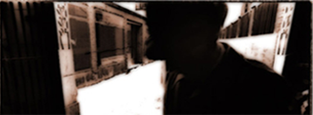A question of grain
A question of grain
Recycling — of industrial debris and old styles — is obviously the keyword of this year’s summer exhibition at the Oslo Museum of Contemporary Art. But owing to their vague direction and questionable relevance, the pieces show insubstantial surface layers instead of content, and disappointingly, the possibility of transformative interactions with the past is conspicuous by its absence.
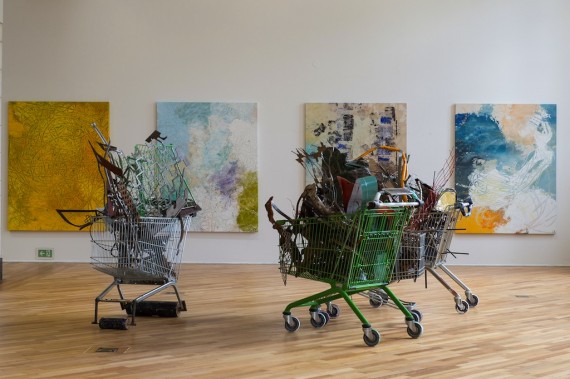
Once upon a time, words like investment, development, valuation, and visions circulated in these ornate, marble halls. Today, what was once a bank has been transformed into a museum for new, young art, but terms like ‘development’ and ‘vision for the future’, should still echo in these walls, mark their presence felt. Now, when the young golden girl of the Norwegian art scene, Ida Ekblad (b. 1980), occupies the space as the fifth promising, young Norwegian artist in a row since 2009 to grace the museum’s series of summer exhibitions, it is surprisingly the opposite of progression we are witnessing. With these halls full of industrial debris, pottery shards, and abstract paintings, it is sooner words like stagnation and regression that hang over the polished floors.
There is one remnant that seems to be intact and which seems to link the bank aesthetics and the Ekblad’s work, and that is, in several ways, the obvious lack of grain; a definition which is normally applied to the granularity and abrasiveness of a surface, mainly with a negative connotation since it indicates unevenness and therefore potential failure. Digital editing and erasing of human, physical defects in fashion pictures is one obvious example of the concept’s more unfortunate embodiments. Virtuoso soloists and their drive for perfection — according to certain conventional ideas within classical music — is another example, perhaps more closely related to art. If you consider banks and their business, they are, of course, obliged to put the issue of reliability at the fore, since it is a necessary aspect of client relations. They need to maintain a neat and clean façade, which fulfils the general expectations of, and provides a foundation for clients’ positive impression and eventual trust.
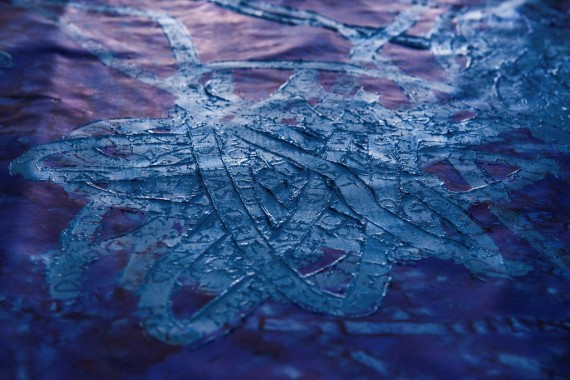
Within the domain of the ‘serious art’, on the other hand, the presence or absence of grain ultimately constitutes a completely different and often determining factor of an actual piece’s reception. Unfortunately, regressive or static ideas of what constitutes ‘good’ or ‘bad’ art, are a current norm in all artistic fields; ‘I like this’ or ‘I don’t like that’, which enforces a kind of aesthetic canon that persistently pleads for and presupposes a level of success and perfection (techniques, processes, looks, recordings, performances, choice of material, form, structure, composition, style rules, etc.). Similarly, its predecessors claim their authority in an often unpleasant way, by deciding the motivation for art and, ultimately, its relevance. In these circles, grain is most often regarded as an obstacle, connected as it is to unpleasant and maybe even embarrassing failures. In other words, preferred artworks are spared any possible extra doubts or ambivalence, since in most cases, these traits remind them of their own personal shortcomings, which they prefer to put aside. For some receivers, the ideal expression is a clear and obvious statement, where a ‘feeling’ can be interpreted, and thus, through readily apparent meaning, reduce the viewing experience into a known, codified emotion, in accordance with prevalent norms and prescribed opinions.
On the other hand, the amount of grain in a piece could — or should — also be regarded as an important and decisive component. Partly, because rough surfaces extends the perspective and creates a depth, but mainly because it derives from a human body, separate from other bodies, whose extended arm or hand incorporates a body into the artwork. This extension resonates further, into other bodies — in a direct way, without any artifice, immediately comprehensible, far from any obvious metaphors or contrasting relationships — speaking to us in a language beyond languages.
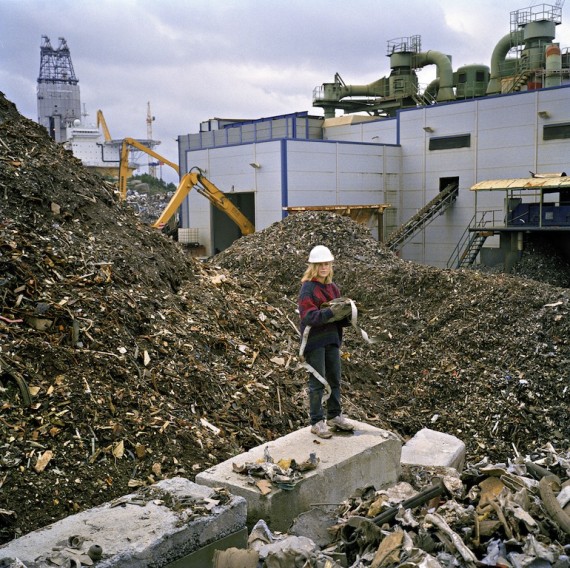
Recycled scrap
According to the exhibition text, Ekblad’s practise of dumpster diving is referred to as ‘Situationist-inspired drifts through the city’. If her intention is to elucidate the inequities of Capitalism by parking eighteen shopping carts filled with painted industrial debris in an old bank hall, then her protest is somewhat naïve, and it does not evoke any feelings of unpleasantness. Nonetheless, the mobility of the sculptures in Wagon/Tracks (2013) contains an interesting performative function, suggesting ceaseless motion, in the exhibition room as well as in the community surrounding us. This is especially evident due to the printed excerpts she has placed on the wheels of these shopping carts, which she then, with seemingly frenetic energy, has rolled over fourteen canvases, which now look down on us from the high walls around. The majority of these text fragments are impossible to read or understand, since they have been demolished through the frenetic repetitions of the creative process. But, in the few cases where it is actually possible to pick complete sentences out of this chaotic puzzle, they fit the mould of vacuous, abstract one-liners: ‘Fatigue clack clack clack chills’, ‘Jellied ghosts of bikes’, or ‘Intricate trap that entangled its victim’. As a consequence, questions arise as to the content and relevance of the work, and the initial feeling of discomfort caused by the piece’s uncontrolled, chaotic character disappears.
The statement that Ekblad works out of street smarts, a trait commented as presumably unique and brave for the art scene, is slightly embarrassing if it alludes to the collection of metal junk in the shopping carts. Her method of dumpster diving seems to be based on short trips by car to a junkyard nearby, where she collects a few aesthetically suitable objects, which she rolls into an old bank in the area, exhibits, and earns money from doing. This has de facto nothing to do with social vulnerability, consistent ideological thinking, or a pure fight for survival. The work of an artist with a clear and outspoken interest in, and courage to handle the rough life on the streets, and who is simultaneously capable of transforming those experiences into artistic expression, would have been interesting to experience. But, that kind of serious exposure seems a far cry from Ekblad’s intentions. However, had that been the case, it would obviously have demanded more earnest investigations in the search for urban semantics for anyone who wanted to explore the mysterious and challenging connection between reality and fiction. Such an investigation would call for intense studies of urban language, intonation, jargon, patterns, structures, colours, and signs. Like a nosy photographer, any such artist should be obliged to observe closely any changes on the surface of the streets and the churning beneath, the violence and degradation, and in addition, have the ability to transcribe these impressions and transform them into significant contemporary visuals.
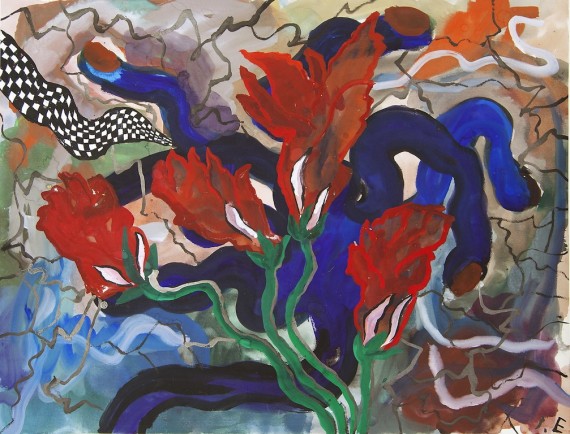
Recycled expressions
When abstract expressionism flows freely, I think of big canvases in intense colours, created powerfully, with passionate gestures, where the actual abstraction transforms after you look at it for a while, and figures and forms rise to the surface from of the initial nothingness; they slowly well up from tangled layers of colour and then completely knock you back. But that’s abstract expressionism at its best. On a good day. I imagine that European proponents like Willem de Kooning, Asger Jorn, and Per Kirkeby had deep personal relations to ‘their’ colours — an ‘ethos of art’ — where they ascribed the various nuances a certain character, almost natural or magical, but in a undoubtedly very personal way; whether through some philosophical detour or a more immediate appeal. They seem to have had an inevitable love-hate feeling for the medium, that extension of their bodies, revoking the inherent complexity of abstraction. Within these artists’ work, there don’t seem to have existed any simple solutions or shortcuts; the completed works were probably a result of industrious chewing over and rumination, the processes resembling a merciless Golgotha on their journey through the self. Today, we can experience a double richness in their work, since it, through its abstract appearance, perhaps more than any other expression in visual art, displays unique self-portraits of the processes involved in its creation.
These attributes are enormously important, and an unavoidable angle of approach when experiencing and discussing all forms for abstractionism. No matter how long and intensely I stare at Ekblad’s paintings, I seem to see and feel neither power nor necessity. What is left in these paintings is something akin to a quick glimpse at the average abstract piece; large format, big gestures, intense colours in several layers, apparently casually applied, and so on. These are general attributes that inform us of the overall art style; a style that occupied a certain number of artists during a certain part of the history. Concordant with her dumpster diving, there is no information available regarding Ekblad’s actual inner visions or ambitions as far her abstract paintings go. The exhibition text describes them as ‘courageous demonstrations of the relevance and feasibility of an expressive artistic gesture’. Rather, this proposed reconstruction and comment on the past becomes an imitation. When I become aware that the paintings are intended to be taken seriously and not ironically, I desperately look for some conceivable cause. After some time walking back and forth, I am left standing, considering how the work seems to be an exercise in painting a certain style. The only possible relevance these paintings could have that I am able to think of, is to Ekblad herself, and then presumably due to as a counterweight to her conceptual processes.
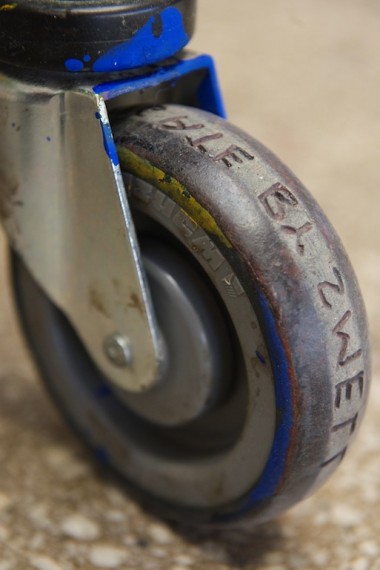
The voices of the forgotten rise from their graves, outlining the text
Recognising your own position in history and to comment on it through your art is without doubt an important part of contemporary art, regardless of genre. But if this interactive comment ends up as ignorant reductionism, imitating old proven mores, the result becomes little more than a pastiche, lacking both relevance and significance. When calling upon tradition, earnest initiatives unfold to bigger dimensions, while the less serious ones come out as pure parasite art. Ekblad’s paintings are not ‘courageous demonstrations of the relevance and feasibility …’ What I find courageous and simultaneously foolhardy, is her copy’s lack of any profound interaction with its original.
I cannot seem to find any attempt on Ekblad’s part to breach general preconceptions in art through art. Instead, she creates something new by imitating the old, and the result is insubstantial and shallow. All the same, her processes seem to be built on an obvious joy and persistence, and that is one solid artistic ccornerstone. However, since her intent is vague and much of her work lacks any content with a transformative potential, the overall experience of this exhibition is a disappointment. Any possible grain or confrontation is conspicuous by its absence. In the halls of this old bank, you will find a profound love for art as a profession, but I am left with a strong desire for the unavoidable fights that await, to see fresh attempts and so-called failures. Here, it is hard to see any extension of a body into other bodies, no arm reaching out to you, no further resonance, no obvious defiance or rage. I wish this were the embodiment of a culture that has the potential to be a thorn in the eye of the oppressive culture that surrounds it: important signs and transcriptions of a potential life, hidden away in a totalitarian urban darkness, the conditions and consequences of which are explored, analysed and exhibited.
But this imitation of the past has, in spite of everything, contributed with one important insight. The imitated has been brought back to life and received a richly deserved renaissance; once again, opening up all your senses towards the past has become unavoidable. The forgotten have risen from their graves, outlining a text about the content and necessity of art. In some cases, the living, who have a responsibility to adopt an inescapably historical position, have buried themselves beneath the copier, which spews material that can be summarized by a vacuous poem, available at the exhibition. Visitors are invited to take a copy. A piece of paper that with a simple movement with your hand ignites, burns up, and disappears.
IDA EKBLAD
25 April – 15 September 2013
Museum of Contemporary Art

